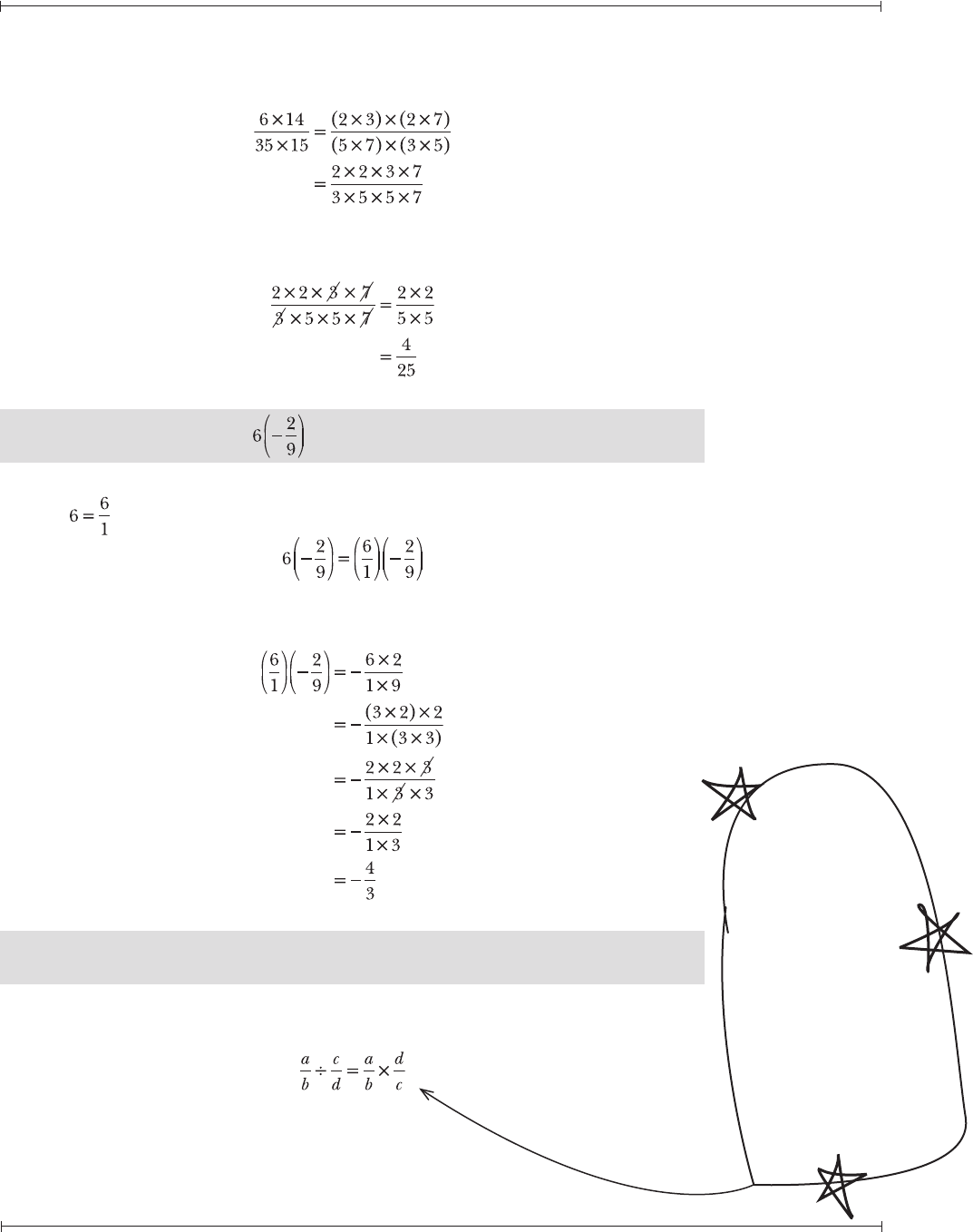
Chapter Two — Rational Numbers
The Humongous Book of Algebra Problems
31
2.32 Use the prime factorization technique described in Problem 2.30 to simplify
the expression: .
Identify the prime factorizations of 945 and 1,575.
Both factorizations include the same factors (3, 5, and 7), so the LCD includes
those factors as well. The highest power of 3 is 3
3
(from the factorization of
945), and the highest power of 5 is 5
2
(from the factorization of 1,575), so apply
those powers to the factors in the LCD. The remaining factor, 7, is raised to the
same power in both factorizations (1).
Divide the LCD by each denominator to identify the value by which you
should multiply to generate the equivalent fractions: and
.
2.33 Simplify the expression: .
Multiplying and dividing fractions does not require a common denominator.
Multiply the numerators of the fractions together and divide by the product of
the denominators.
To reduce the fraction to lowest terms, divide the numerator and denominator
by 2.
6 ÷ 2
40 ÷ 2
Both numbers
are divisible by 5:
945 = (5)(189)
and 1,575 = (5)(315).
Additionally, 189 and 315
are divisible by 9:
945 = (5)(9)(21) and
1,575 = (5)(9)(35). Finally,
21 and 35 are both
divisible by 7.

Chapter Two — Rational Numbers
The Humongous Book of Algebra Problems
32
Note: Problems 2.34–2.35 refer to the expression .
2.34 Simplify the expression using the method described in Problem 2.33.
Multiply the numerators and divide by the product of the denominators. Note
that the product of numbers with different signs is negative.
Divide 126 and 504 by their greatest common factor (126) to reduce the
fraction.
Note: Problems 2.34–2.35 refer to the expression .
2.35 Reduce the numerators and denominators of the expression before calculating
the product.
If a number in any numerator shares a common factor with a number in any
denominator, it is beneficial to express the numbers as products that include
the common factor. Here, the left numerator and the right denominator share
the common factor 7; the left denominator and the right numerator share the
common factor 18.
Multiply the fractions together but do not calculate the individual products.
Eliminate the matching pairs of factors in the numerator and denominator.
No factors remain in the numerator other than the (usually) unwritten factor 1.
Notice that this answer and the answer to Problem 2.34 are equal. The method
you use to multiply the fraction has no affect on the product.
2.36 Simplify the expression: .
Write the product as a single fraction.
This is a great
trick because your
answers won’t need
to be reduced at the
end of the problem.
In other words,
leave it as a big string
of numbers multiplied
together.
If you
cross out a
7 in the top of
the fraction, you
can cross out a 7
in the denominator.
It’s a one-for-one
exchange—one
number on the top
for one matching
number on the
bottom.

Chapter Two — Rational Numbers
The Humongous Book of Algebra Problems
33
Identify common factors of the numerator and denominator: 6 and 15 have
common factor 3; 14 and 35 have common factor 7. Rewrite the fraction so that
the common factors are explicitly identified.
Eliminate pairs of common factors from the numerator and denominator to
reduce the fraction.
2.37 Simplify the expression: .
Integers are rational numbers, as any number divided by 1 is equal to itself:
.
Multiply the fractions. Note that 6 and 9 have common factor 3.
2.38 Describe the relationship between multiplying and dividing fractions.
Dividing by a fraction is equivalent to multiplying by the reciprocal of that
fraction.
Some stu-
dents call this
the KFC rule (it
has nothing to do
with chicken), which
stands for keep, ip,
change. When you
divide something by
a fraction, KEEP the
rst fraction the same,
FLIP the fraction you’re
dividing by (take the
reciprocal), and CHANGE
the division sign to a
multiplication sign.

Chapter Two — Rational Numbers
The Humongous Book of Algebra Problems
34
2.39 Simplify the expression: .
Express the integer as a rational number and rewrite the quotient as a
product, using the method described in Problem 2.38.
Multiply the fractions and reduce the product to lowest terms.
2.40 Simplify the expression: .
Rewrite the quotient as a product, multiply the fractions, and write the result in
lowest terms. Recall that the quotient (and product) of two negative numbers is
positive.
So dividing by
2 is the same as
multiplying by
.
That makes sense—
dividing a number by
2 and taking half of
the number mean
the same thing.
If you don’t
like looking for
common factors and
canceling them out, you
don’t have to. You can
always wait until the
very last step and divide
by the greatest common
factor. However, it’s
usually easier to spot
common factors
when the numbers
are smaller.

Chapter Two — Rational Numbers
The Humongous Book of Algebra Problems
35
2.41 Simplify the complex fraction: .
A complex fraction contains a fraction in its numerator, denominator, or
both. This fraction is complex because its denominator is the fraction . All
fractions, including complex fractions, can be rewritten as a quotient.
Convert the quotient into a product, calculate the product, and reduce the
result to lowest terms.
2.42 Simplify the complex fraction: .
Use the method described in Problem 2.41: Rewrite the complex fraction as a
quotient and then as a product. Calculate the product and ensure the result is
reduced to lowest terms.
..................Content has been hidden....................
You can't read the all page of ebook, please click here login for view all page.
